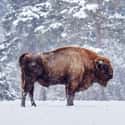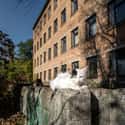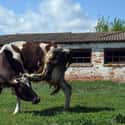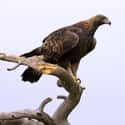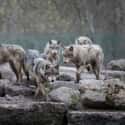-
(#3) Swallows Living In The Red Zone Have Deformed Beaks
In the aftermath of the Chernobyl incident, it wasn't just the land animals who felt the effects of radiation. Birds have proven to be particularly affected by nuclear fallout. This is particularly true for the barn swallows around Chernobyl. In the early 2000s, the barn swallow population was observed to have several horrific mutations, including deformed beaks, disproportionate feathers, partial albinism, and significantly smaller brains.
-
(#9) The Belarus Region Contains Radioactive Bison
In a terrifying place where eagles soar, abandoned buildings collapse, and radioactive greenery sprouts up through the cracks of a forgotten countryside, the only competition for contaminated wolves is radioactive bison. These colossal beasts can weigh up to 2,200 pounds and they challenge predators with their size.
Bison become irradiated by their food consumption even now as they reside in Chernobyl’s notorious exclusion zone.
-
(#8) Radioactive Kittens Come Back Feral And With A Vengeance
In the wake of the notorious Chernobyl event, pet cats were abandoned and eventually gave rise to a rash of feral descendants. Feral cats roam in and out of the exclusion zone, snacking on radioactive rodents and insects.
Over 100 stray cats live in the exclusion zone, and efforts are underway for many of them to be adopted.
-
(#7) Radioactive Cows Are Producing Toxic Milk
The area around Chernobyl was a bustling agricultural center before the meltdown. When people left, they took their farm animals too. But new generations born from these radioactive animals showed extreme genetic mutations and deformities. In 1989, farmers reported birth defects in their animals; one cow even had a mutated cleft lip.
As the years wore on, cows continued to graze on contaminated feed and internally develop less physically apparent complications. Despite looking relatively normal, cows near the zone produce toxic milk not fit for consumption.
-
(#5) Radioactive Eagles Set Up Shop In Abandoned Watch Towers
Endangered white-tailed eagles are seemingly thriving in Ukraine. For the birds, this means being subject to varying deformities ranging from tumors to disproportionate beaks to decreased rates of fertility. Even still, the Chernobyl exclusion zone is said to contain 249 species of radioactive birds, with the mighty eagles making a serious comeback for the first time in over a century.
On any given blustery winter day, beyond the limits and eyes of humanity, eagles build nests in abandoned watch towers, adding an air of formidability to the atmosphere.
-
(#1) In The Radioactive Red Forest, Fierce Gray Wolves Reign
Following the disastrous fallout of the Chernobyl meltdown, trees temporarily took on a rather peculiar shade of crimson, and the region within the close proximity of the reactor received the moniker “Red Forest.” In the Red Forest, radioactive wolves are apex predators, with some studies suggesting their population is approximately seven times higher than that of comparable sites.
The animals have roamed far and wide, a problem as their carcasses are toxic to touch.
New Random Displays Display All By Ranking
About This Tool
Chernobyl has become synonymous with disaster. The nuclear disaster in 1986 caused thousands of people to suffer from cancer, and the once densely populated area became a ghost town. But the Chernobyl quarantine zone is not without life. Wild animals such as wolves, wild boars, and bears have returned to the surrounding dense forests, and most of the radioactive animals have survived. In contrast, the vitality of nature is shocking.
After the nuclear power plant exploded, a large number of creatures died, but radioactive animals appeared and seem to have strong self-healing abilities, their genes had changed, and their body shape and fur color might also change. The random tool displays 9 fascinating radioactive animals in Chernobyl.
Our data comes from Ranker, If you want to participate in the ranking of items displayed on this page, please click here.











